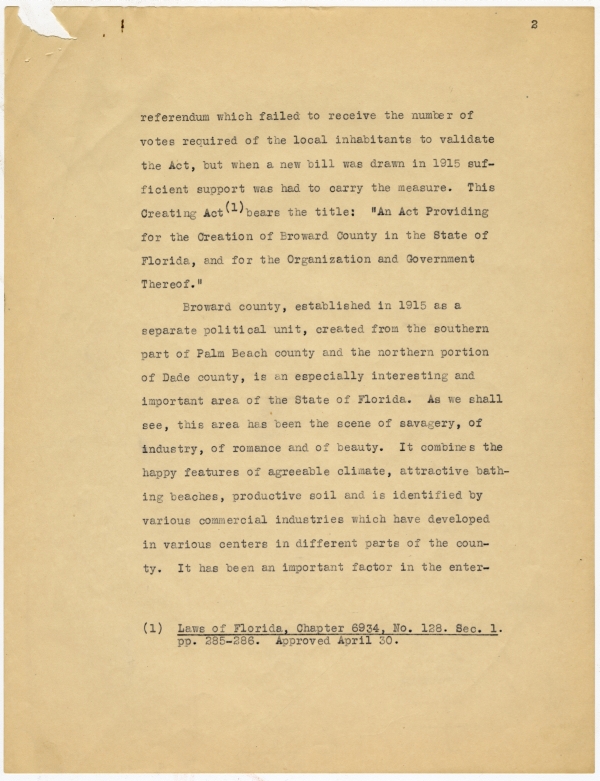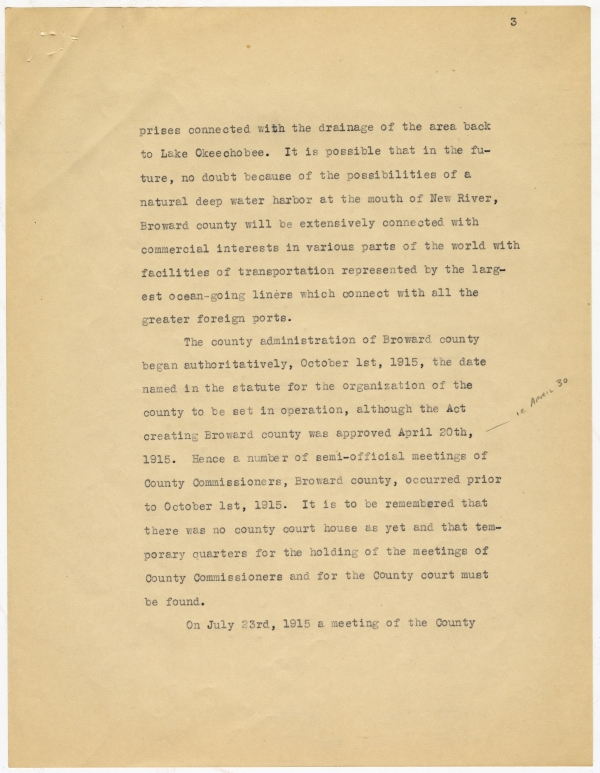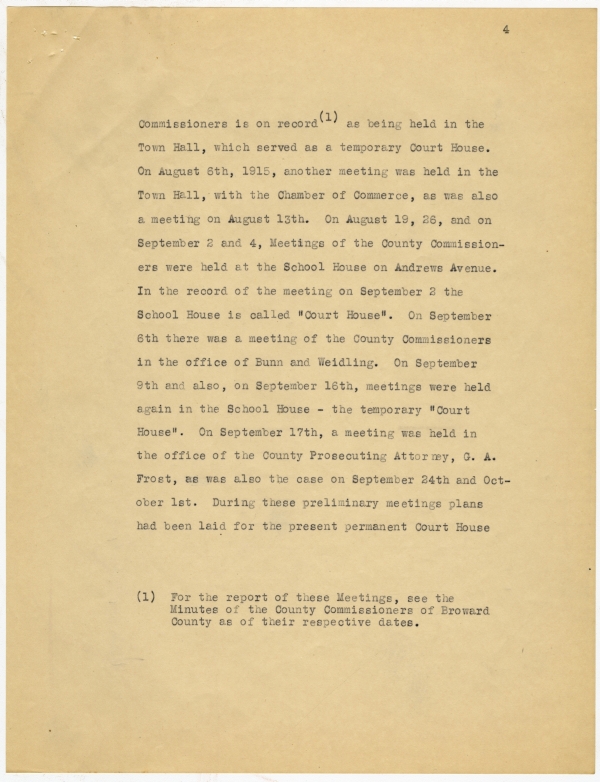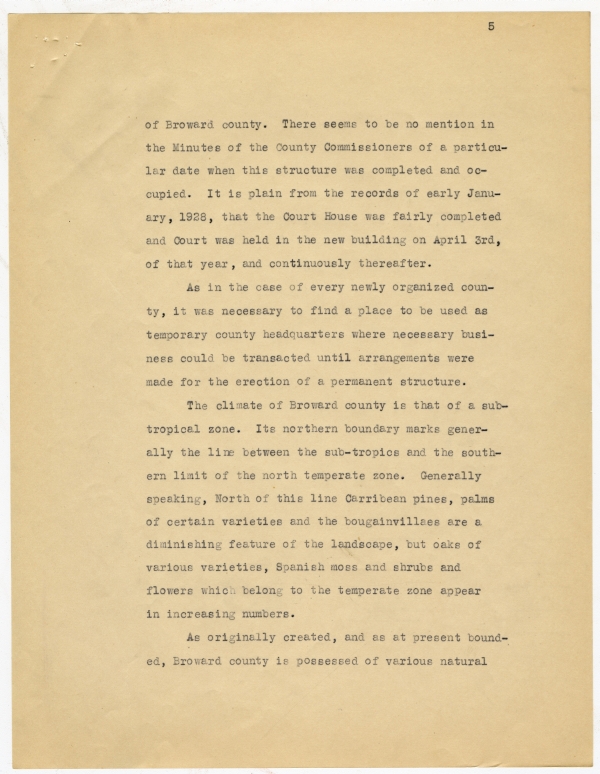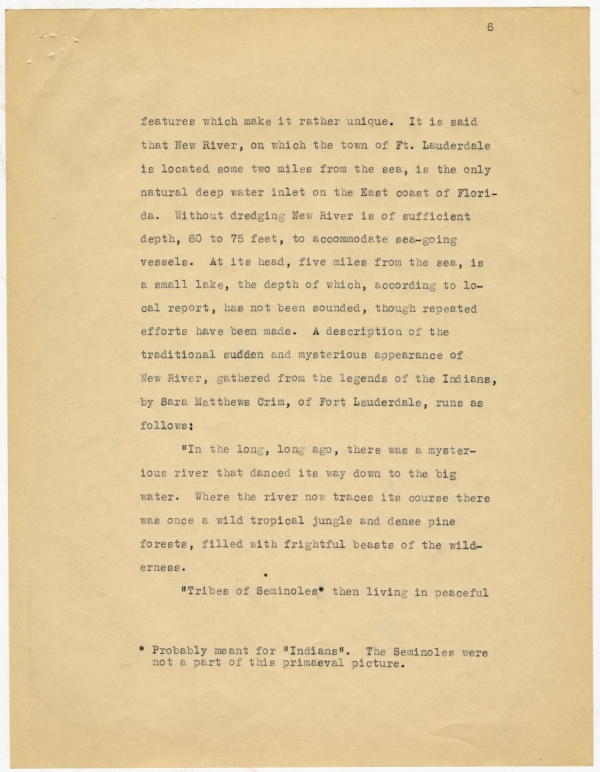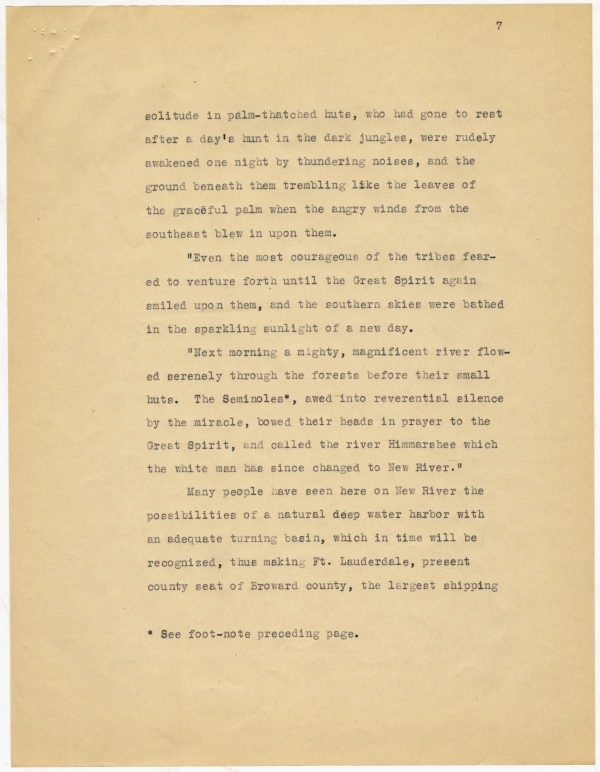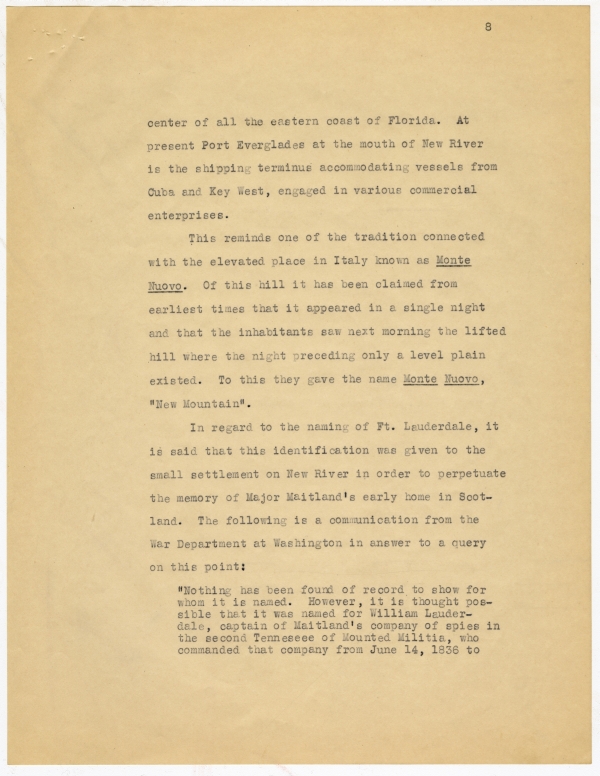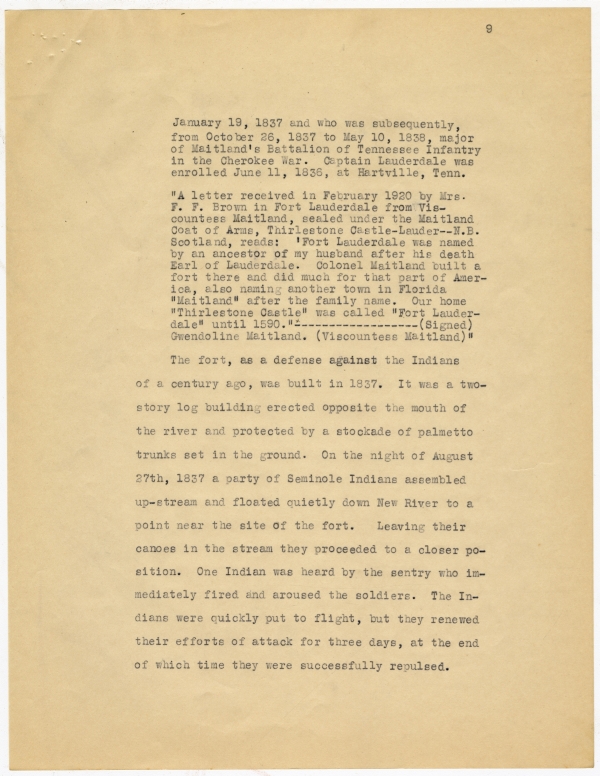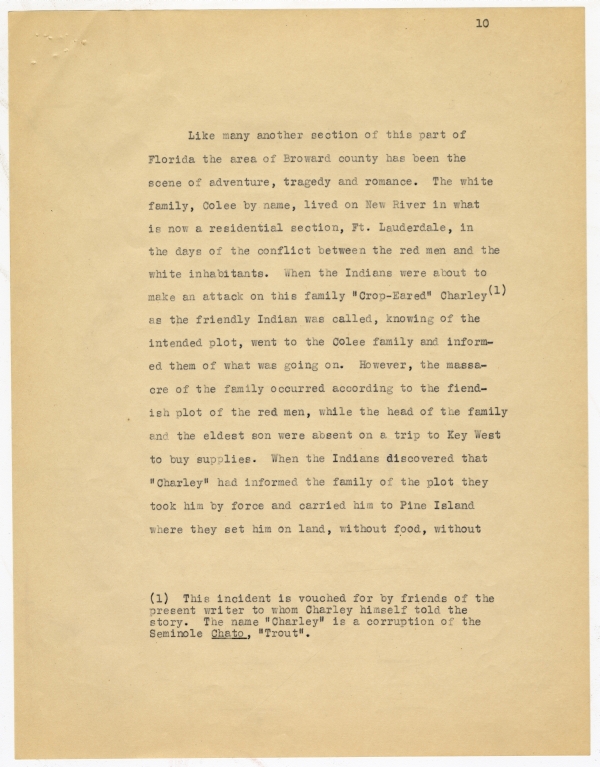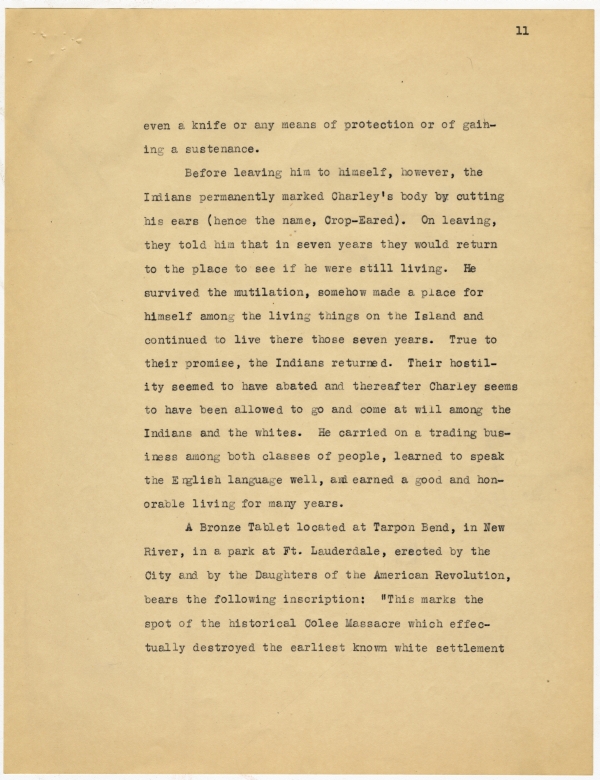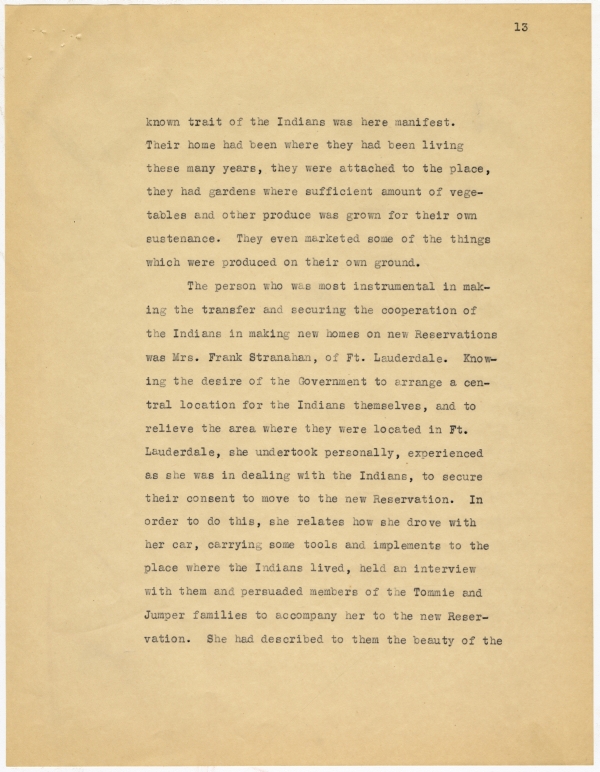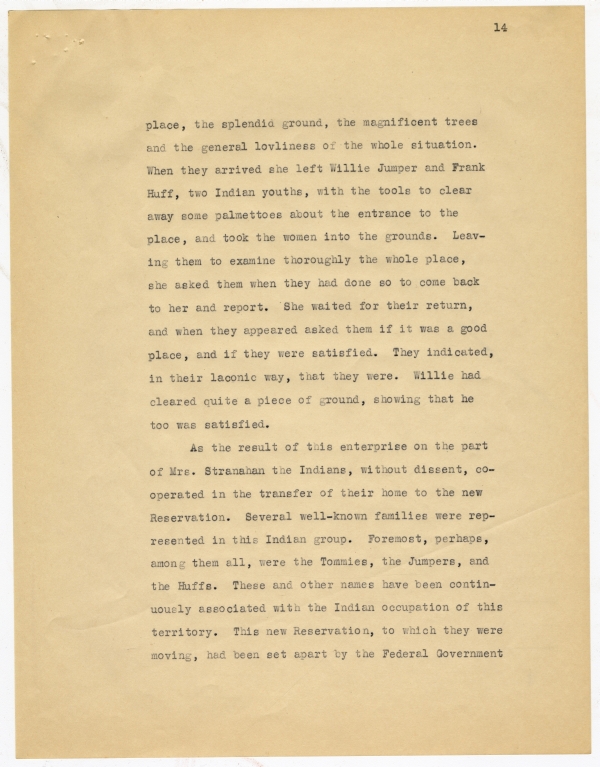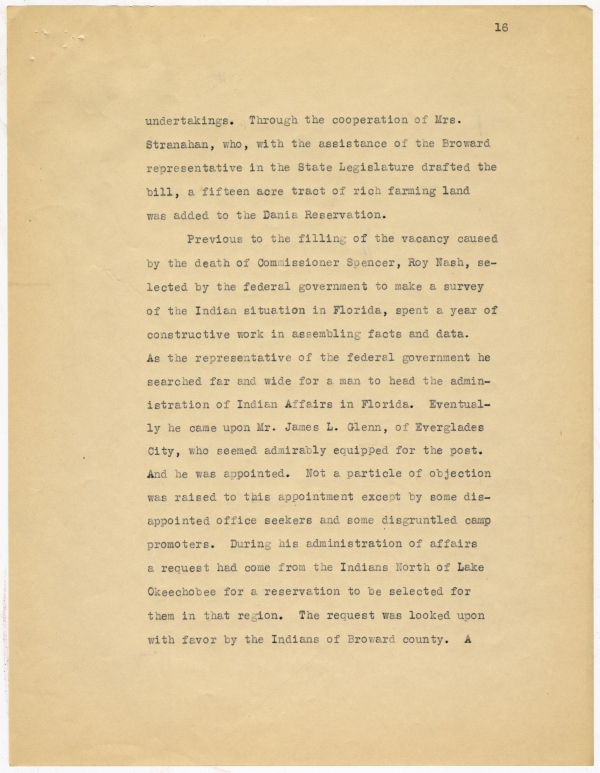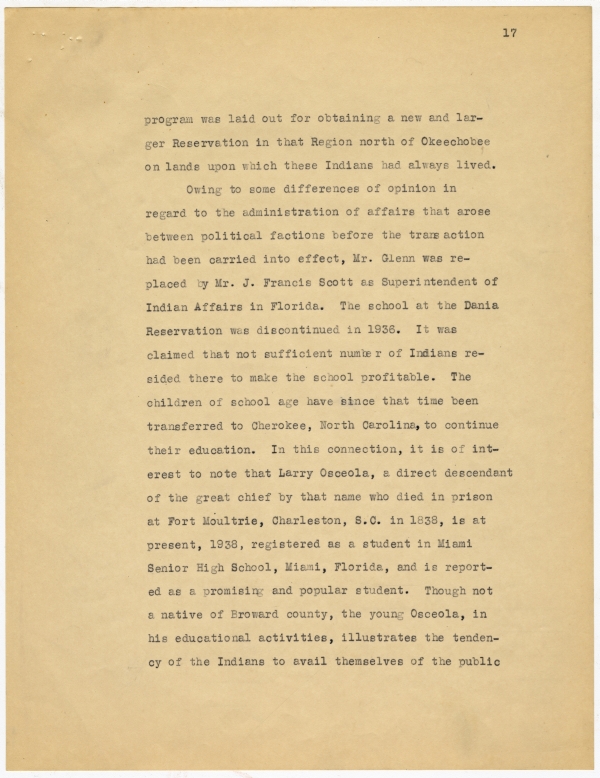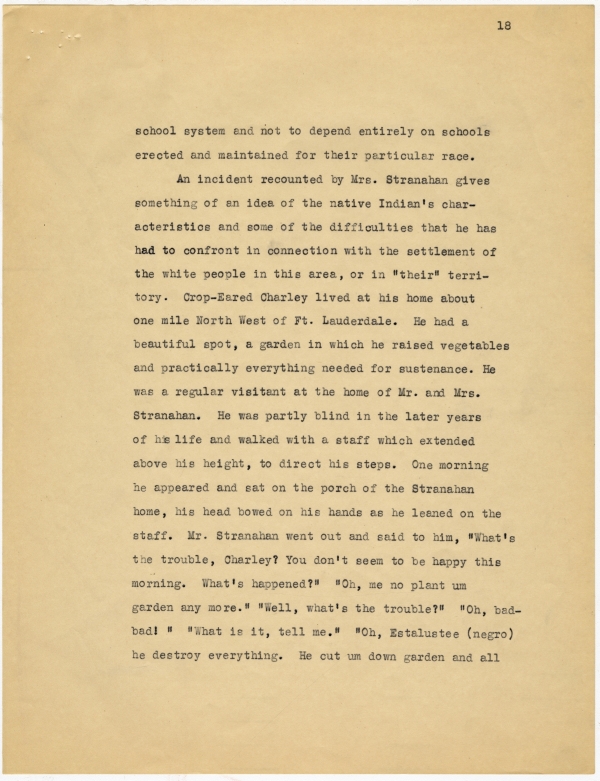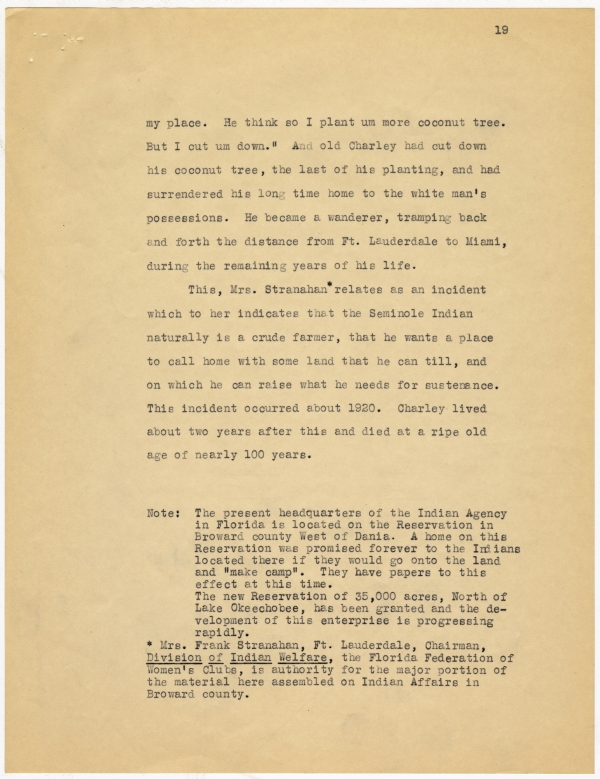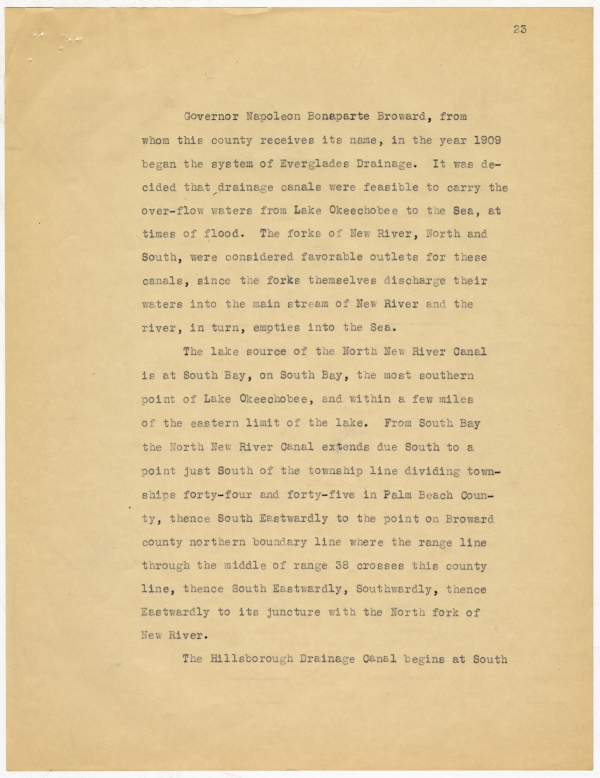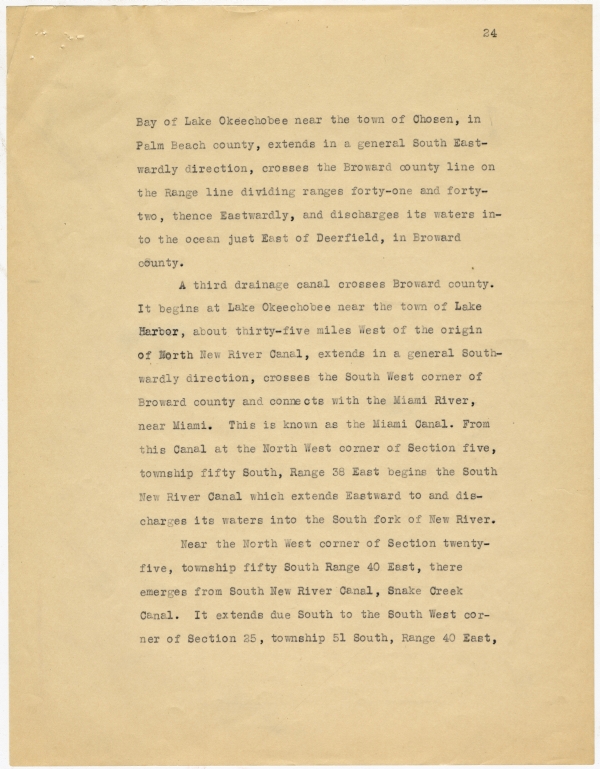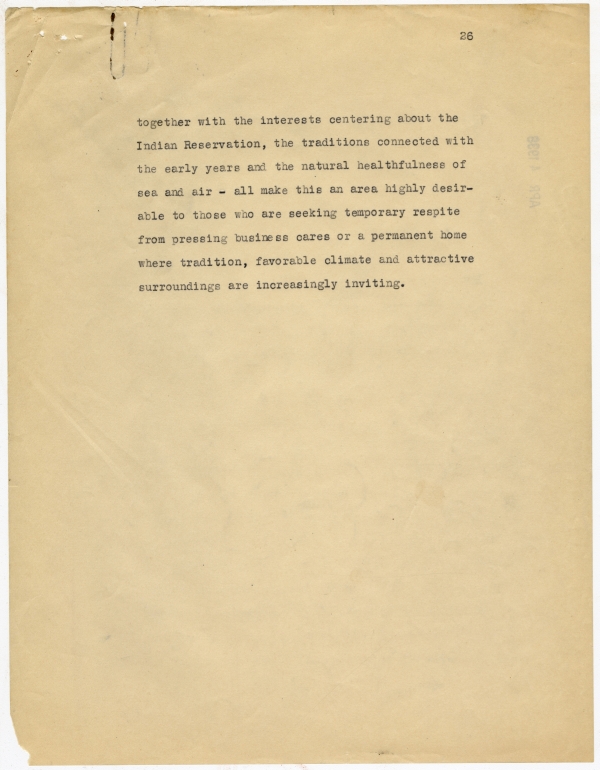Transcript
WPA
A BRIEF HISTORICAL SKETCH
of
BROWARD COUNTY
The rising interest among the local citizens of Ft. Lauderdale and of the adjacent communities in favor of a new political unit to be organized embracing the area of the existing counties which they represented resulted, in 1915, in the creating of Broward County. The citizens who lived in this section prior to the organization of the new county were obliged to go either to Palm Beach on the North or to Miami on the South, to transact business relative to the interests which centered in their county relationships. This was an inconvenience and often an embarrassmnet because of the amount of time required and the distance that must be travelled in order to consummate the business in hand. The rising interest in the importance of Ft. Lauderdale as a possible county seat of a new county encouraged the people of this area to undertake the project of the organization of such a county.
A similar effort had been made in the year 1913. An Act had been drawn and passed by the State Legislature. Provision was made in that Act for a
2
referendum which failed to receive the number of votes required of the local inhabitants to validate the Act, but when a new bill was drawn in 1915 sufficient support was had to carry the measure. This Creating Act (1) bears the title: "An Act Providing for the Creation of Broward County in the State of Florida, and for the Organization and Government Thereof."
Broward county, established in 1915 as a separate political unit, created from the southern part of Palm Beach county and the northern portion of Dade county, is an especially interesting and important area of the State of Florida. As we shall see, this area has been the scene of savagery, of industry, of romance and of beauty. It combines the happy features of agreeable climate, attractive bathing beaches, productive soil and is identified by various commercial industries which have developed in various centers in different parts of the county. It has been an important factor in the enter
(1) Laws of Florida, Chapter 6934, No. 128. Sec. 1. pp. 285-286. Approved April 30.
3
prises connected with the drainage of the area back to Lake Okeechobee. It is possible that in the future, no doubt because of the possibilities of a natural deep water harbor at the mouth of New River, Broward county will be extensively connected with commercial interests in various parts of the world with facilities of transportation represented by the largest ocean-going liners which connect with all the greater foreign ports.
The county administration of Broward county began authoritatively, October 1st, 1915, the date named in the statute for the organization of the county to be set in operation, although the Act creating Broward county was approved April 30th, 1915. Hence a number of semi-official meetings of County Commissioners, Broward county, occurred prior to October 1st, 1915. It is to be remembered that there was no county court house as yet and that temporary quarters for the holding of the meetings of County Commissioners and for the County court must be found.
On July 23rd, 1915 a meeting of the County
4
Commissioners is on record (1) as being held in the Town Hall, which served as a temporary Court House. On August 6th, 1915, another meeting was held in the Town Hall, with the Chamber of Commerce, as was also a meeting on August 13th. On August 19, 26, and on September 2 and 4, Meetings of the County Commissioners were held at the School House on Andrews Avenue. In the record of the meeting on September 2 the School House is called "Court House". On September 6th there was a meeting of the County Commissioners in the office of Bunn and Weidling. On September 9th and also, on September 16th, meetings were held again in the School House - the temporary "Court House". On September 17th, a meeting was held in the office of the County Prosecuting Attorney, G. A. Frost, as was also the case on September 24th and October 1st. During these preliminary meetings plans had been laid for the present permanent Court House (1) For the report of these Meetings, see the Minutes of the County Commissioners of Broward County as of their respective dates.
5
of Broward county. There seems to be no mention in the Minutes of the County Commissioners of a particular date when this structure was completed and occupied. It is plain from the records of early January, 1928, that the Court House was fairly completed and Court was held in the new building on April 3rd, of that year, and continuously thereafter.
As in the case of every newly organized county, it is necessary to find a place to be used as temporary county headquarters where necessary business could be transacted until arrangements were made for the erection of a permanent structure.
The climate of Broward county is that of a subtropical zone. Its northern boundary marks generally the line between the sub-tropics and the southern limit of the north temperate zone. Generally speaking, North of this line [Caribbean] pines, palms of certain varieties and the [bougainvilleas] are a diminishing feature of the landscape, but oaks of various varieties, Spanish moss and shrubs and flowers which belong to the temperate zone appear in increasing numbers.
As originally created, and as at present bounded, Broward county is possessed of various natural
6
features which make it rather unique. It is said that New River, on which the town of Ft. Lauderdale is located some two miles from the sea, is the only natural deep water inlet on the East coast of Florida. Without dredging New River is of sufficient depth, 60 to 75 feet, to accommodate sea-going vessels. At its head, five miles from the sea, is a small lake, the depth of which, according to local report, has not been sounded, though repeated efforts have been made. A description of the traditional sudden and mysterious appearance of New River, gathered from the legends of the Indians, by Sara Matthews Crim, of Fort Lauderdale, runs as follows:
"In the long, long ago, there was a mysterious river that danced its way down to the big water. Where the river now traces its course there was once a wild tropical jungle and dense pine forests, filled with frightful beasts of the wilderness.
"Tribes of Seminoles* then living in peaceful
* Probably meant for "Indians". The Seminoles were not a part of this primaeval picture.
7
solitude in palm-thatched huts, who had gone to rest after a day's hunt in the dark jungles, were rudely awakened one night by thundering noises, and the ground beneath them trembling like the leaves of the graceful palm when the angry winds from the southeast blew in upon them.
"Even the most courageous of the tribes feared to venture forth until the Great Spirit again smiled upon them, and the southern skies were bathed in sparkling sunlight of a new day.
"Next morning a mighty, magnificent river flowed serenely through the forests before their small huts. The Seminoles*, awed into reverential silence by the miracle, bowed their heads in prayer to the Great Spirit, and called the river Himmarshee which the white man has since changed to New River."
Many people have seen here on New River the possibilities of a natural deep water harbor with an adequate turning basin, which in time will be recognized, thus making Ft. Lauderdale, present county seat of Broward county, the largest shipping
* See foot-note preceding page.
8
center of all the eastern coast of Florida. At present Port Everglades at the mouth on New River is the shipping terminus accommodating vessels from Cuba and Key West, engaged in various commercial enterprises.
This reminds one of the tradition connected with the elevated place in Italy known as Monte Nuovo. Of this hill it has been claimed from earliest times that it appeared in a single night and that the inhabitants saw next morning the lifted hill where the night preceding only a level plain existed. To this they gave the name Monte Nuovo, "New Mountain".
In regard to the naming of Ft. Lauderdale, it is said that this identification was given to the small settlement on New River in order to perpetuate the memory of Major Maitland's early home in Scotland. The following is a communication from the War Department at Washington in answer to a query on this point:
"Nothing has been found of record to show for whom it is named. However, it is thought possible that it was named for William Lauderdale, captain of Maitland's company of spies in the second [Tennessee] of Mounted Militia, who commanded that company from June 14, 1836 to
9
January 19, 1837 and who was subsequently, from October 26, 1837 to May 10, 1838, major of Maitland's Battalion of Tennessee Infantry in the Cherokee War. Captain Lauderdale was enrolled June 11, 1836, at Hartville, Tenn.
"A letter received in February 1920 by Mrs. F. F. Brown in Fort Lauderdale from Viscountess Maitland, sealed under the Maitland Coat of Arms, Thirlestone Castle-Lauder--N.B. Scotland, reads: 'Fort Lauderdale was named by an ancestor of my husband after his death Earl of Lauderdale. Colonel Maitland built a fort there and did much for that part of America, also naming another town in Florida "Maitland" after the family name. Our home "Thirlestone Castle" was called "Fort Lauderdale" until 1590."-----------------(Signed) Gwendoline Maitland. (Viscountess Maitland)"
The fort, as a defense against the Indians of a century ago, was built in 1837. It was a two story log building erected opposite the mouth of the river and protected by a stockade of palmetto trunks set in the ground. On the night of August 27th, 1837 a party of Seminole Indians assembled up-stream and floated quietly down New River to a point near the site of the fort. Leaving their canoes in the stream they proceeded to a closer position. One Indian was heard by the sentry who immediately fired and aroused the soldiers. The Indians were quickly put to flight, but they renewed their efforts of attack for three days, at the end of which time they were successfully repulsed.
10
Like many another section of this part of Florida the area of Broward county has been the scene of adventure, tragedy and romance. The white family, Colee by name, lived on New River in what is now a residential section, Ft. Lauderdale, in the days of the conflict between the red men and the white inhabitants. When the Indians were about to make an attack on this family "Crop-Eared" Charley (1) as the friendly Indian was called, knowing of the intended plot, went to the Colee family and informed them of what was going on. However, the massacre of the family occurred according to the fiendish plot of the red men, while the head of the family and the eldest son were absent on a trip to Key West to buy supplies. When the Indians discovered that "Charley" had informed the family of the plot they took him by force and carried him to Pine Island where they set him on land, without food, without
(1) This incident is vouched for by friends of the present writer to whom Charley himself told the story. The name "Charley" is a corruption of the Seminole Chato, "Trout".
11
even a knife or any means of protection or of gaining a sustenance.
Before leaving him to himself, however, the Indians permanently marked Charley's body by cutting his ears (hence the name, Crop-Eared). On leaving, they told him that in seven years they would return to the place to see if he were still living. He survived the multilation, somehow made a place for himself among the living things on the Island and continued to live there those seven years. True to their promise, the Indians returned. Their hostility seemed to have abated and thereafter Charley seems to have been allowed to go and come at will among the Indians and the whites. He carried on a trading business among both classes of people, learned to speak the English language well, and earned a good and honorable living for many years.
A Bronze Tablet located at Tarpon Bend, in New River, in a part at Ft. Lauderdale, erected by the City and by the Daughters of the American Revolution, bears the following inscription: "This marks the spot of the historical Colee Massacre which effectually destroyed the earliest known white settlement
12
on New River in a surprise attack by Indians following Seminole Indian War, - 1842."
The story of governmental control and direction of Indian affairs in Broward county within the last few years is of decided interest and importance. Some years ago Reservation of a Quarter Section of land situated four and one-tenth miles west of the town of Dania was set apart by the Government for the purpose of making a permanent home for the Indians who were living in this section. The need for assembling the Indians on this Reservation where they could be properly cared for arose from the fact that the growing white population at various points in Broward county, especially on New River in the vicinity of Fort Lauderdale, made necessary improved sanitary conditions in this whole immediate area. It became necessary in the mind of the Federal Government to make a permanent establishment for the Indians in a place which they could call their own. The task of gaining the consent of the Indians to leave the homes that they had established West of and within the limits of Ft. Lauderdale, and of moving them to a new Reservation was not an easy one. The common and well
13
known trait of the Indians was here manifest. Their home had been where they had been living these many years, they were attached to the place, they had gardens where sufficient amount of vegetables and other produce was grown for their own sustenance. They even marketed some of the things which were produced on their own ground.
The person who was most instrumental in making the transfer and securing the cooperation of the Indians in making new homes on new Reservations was Mrs. Frank Stranahan, of Ft. Lauderdale. Knowing the desire of the Government to arrange a central location for the Indians themselves, and to relieve the area where they were located in Ft. Lauderdale, she undertook personally, experienced as she was in dealing with the Indians, to secure their consent to move to the new Reservation. In order to do this, she relates how she drove with her car, carrying some tools and implements to the place where the Indians lived, held an interview with them and persuaded members of the Tommie and Jumper families to accompany her to the new Reservation. She had described to them the beauty of the
14
place, the splendid ground, the magnificent trees and the general lovliness of the whole situation. When they arrived she left Willie Jumper and Frank Huff, two Indian youths, with the tools to clear away some palmettoes about the entrance to the place, and took the women into the grounds. Leaving them to examine thoroughly the whole place, she asked them when they had done so to come back to her and report. She waited for their return, and when they appeared asked them if it was a good place, and if they were satisfied. They indicated, in their laconic way, that they were. Willie had cleared quite a piece of ground, showing that he too was satisfied.
As the result of this enterprise on the part of Mrs. Stranahan the Indians, without dissent, cooperated in the transfer of their home to the new Reservation. Several well-known families were represented in this Indian group. Foremost, perhaps, among them all, were the Tommies, the Jumpers, and the Huffs. These and other names have been continuously associated with the Indian occupation of this territory. This new Reservation, to which they were moving, had been set apart by the Federal Government
15
in 1897-98. Mr. Lucian A. Spencer was appointed Commissioner of Indian Affars for the State of Florida. Buildings were constructed for purposes of administration. A school and an infirmary were built. Several small cabins were erected, perhaps a dozen of them in number, for the accommodation of the families who expected to live there. This particular group of Indians has spent its entire life in Broward county and, contrary to reports of some, have not been brought to this section from other parts. These Indians are the first Florida Indians to take up residence on a federal Reservation, and it is through their example and influence that other Indians are going to settle on other federal Reservations.
It so happened the Superintendent, Mr. Spencer, died while he was in the midst of taking a Census of the Indian population, perhaps from exposure, in his effort to make his way through the deep cypress swamp and the places where these people made their temporary abode.
Mrs. Stranahan had cooperated [through] the years very closely with Mr. Spencer in all his laborious
16
undertakings. Through the cooperation of Mrs. Stranahan, who, with the assistance of the Broward representative in the State Legislature drafted the bill, a fifteen acre tract of rich farming land was added to the Dania Reservation.
Previous to the filling of the vacancy caused by the death of Commissioner Spencer, Roy Nash, selected by the federal government to make a survey of the Indian situation in Florida, spent a year of constructive work in assembling facts and data. As the representative of the federal government he searched far and wide for a man to head the administration of Indian Affairs in Florida. Eventually he came upon Mr. James L. Glenn, of Everglades City, who seemed admirably equipped for the post. And he was appointed. Not a particle of objection was raised to this appointment except by some disappointed office seekers and some disgruntled camp promoters. During his administration of affairs a request had come from the Indians North of Lake Okeechobee for a reservation to be selected for them in that region. The request was looked upon with favor by the Indians of Broward county. A
17
program was laid out for obtaining a new and larger Reservation in that Region north of Okeechobee on lands upon which these Indians had always lived.
Owing to some differences of opinion in regard to the administration of affairs that arose between political factions before the transaction had been carried into effect, Mr. Glenn was replaced by Mr. J. Francis Scott as Superintendent of Indian Affairs in Florida. The school at the Dania Reservation was discontinued in 1936. It was claimed that not sufficient number of Indians resided there to make the school profitable. The children of school age have since that time been transferred to Cherokee, North Carolina, to continue their education. In this connection, it is of interest to note that Larry Osceola, a direct descendant of the great chief by that name who died in prison in Fort Moultrie, Charleston, S.C. in 1838, is at present, 1938, registered as a student in Miami Senior High School, Miami, Florida, and is reported as a promising and popular student. Though not a native of Broward county, the young Osceola, in his educational activities, illustrates the tendency of the Indians to avail themselves of the public
18
school system and not to depend entirely on schools erected and maintained for their particular race.
An incident recounted by Mrs. Stranahan gives something of an idea of the native Indian's characteristics and some of the difficulties that he has had to confront in connection with the settlement of the white people in this area, or in "their" territory. Crop-Eared Charley lived at his home about one mile North West of Ft. Lauderdale. He had a beautiful spot, a garden in which he raised vegetables and practically everything needed for sustenance. He was a regular visitant at the home of Mr. and Mrs. Stranahan. He was partly blind in the later years of his life and walked with a staff which extended above his height, to direct his steps. One morning he appeared and sat on the porch of the Stranahan home, his head bowed on his hands as he leaned on the staff. Mr. Stranahan went out and said to him, "What's the trouble, Charley? You don't seem to be happy this morning. What's happened?" "Oh, me no plant um garden any more." "Well, what's the trouble?" "Oh, bad bad!" "What is it, tell me." "Oh Estalustee (negro) he destroy everything. He cut um down garden and all
19
my place. He think so I plant um more coconut tree. But I cut um down." And old Charley had cut down his coconut tree, the last of his planting, and had surrendered his long time home to the white man's possessions. He became a wanderer, tramping back and forth the distance from Ft. Lauderdale to Miami, during the remaining years of his life.
This, Mrs. Stranahan* relates as an incident which to her indicates that the Seminole Indian naturally is a crude farmer, that he wants a place to call home with some land that he can till, and on which he can raise what he needs for sustenance. This incident occurred about 1920. Charley lived about two years after this and died at a ripe old age of nearly 100 years.
Note: The present headquarters of the Indian Agency in Florida is located on the Reservation in Broward county West of Dania. A home on this Reservation was promised forever to the Indians located there if they would go onto the land and "make camp". They have papers to this effect at this time.
The new Reservation of 35,000 acres, North of Lake Okeechobee, has been granted and the development of this enterprise is progressing rapidly.
* Mrs. Frank Stranahan, Ft. Lauderdale, Chairman, Division of Indian Welfare, the Florida Federation of Women's Clubs, is authority for the major portion of the material here assembled on Indian Affairs in Broward county.
20
Following the close of Indian hostilities as expressed in the Colee Massacre, the first white settler in Broward county is said to have been Dennis O'Neill, sent by the Government to take charge of the House of Refuge, at Las Olas Beach, in 1888. According to the memorandum perserved in his Memoirs, "Once a week the mail man would drop in on his way to Miami - Occasionally there would be people with him. Once I remember Rube Burroughs, noted train robber of those days, passed my house on his way to New Orleans. Later I found out who he was, and that he had been shot by officers in New Orleans."
The first school in Ft. Lauderdale opened in 1899 and was conducted by Miss Ivy J. Cromartie. Soon after this Miss Cromartie became the wife of Mr. Stranahan and together they lived at the trading post near the site of the present residence until Mr. Stranahan's death in 1929.
The first railroad through Broward county, completed by Henry M. Flagler, brought its first train to Ft. Lauderdale in February 1896. At that time passengers for Miami were transferred to that place by stage. But in April of the same year the Flagler System was completed to Miami.
21
The Coast Guard of Ft. Lauderdale in its present location is an outgrowth of the old House of Rufuge mentioned above. It has accommodations for 150 men and 15 officers. This base provides headquarters for officers and space and equipment for necessary shops, armory, hospital, radio station and recreation hall.
It is possible to travel by boat on inland water ways from Ft. Lauderdale to almost any portion of the State of Florida. For this reason the place has been called the Venice of the Tropics. The City of Ft. Lauderdale was incorporated under the provisions of a charter dated 1911.
Hollywood, Broward county, is widely known for its beautiful and attractive bathing beaches and for the magnificent hotel called "Hollywood-by-the-Sea". Wyldwoode Park displays in its tropical gardens the Two-Million Dollar Banyan Tree, so-called because some enthusiast is said to have offered that amount to have the tree transplanted to his lawn. [The] Tree, it is said, could not be moved.
Hallandale is the southernmost town in Broward county nearest to the northern border of
22
Dade County.
Dania, as we have seen, is notable by reason of its nearness to the headquarters of the Indian Reservation. This town is located in a rich agricultural region and is widely known as the center of extensive vegetable growing section. In March each year the tomato festival is held in Dania which has attracted very considerable attention in many parts of the country.
A number of other smaller communities in Broward county add to the wealth, productiveness, attractiveness, and to its desirability as a place of residence.
By a rare coincidence, while this article is in preparation, announcement is made of ceremonies conducted by the Daughters of the American Revolution at the site of the Bronze Tablet marking the location of Old Fort Lauderdale, March 16th, 1938. The dedication of the monument at this point is reported as the central feature of the program celebrating the 100th Anniversary of the erection of the old original fort on this spot.
23
Governor Napoleon Bonaparte Broward, from whom this county receives its name, in the year 1909 began the system of Everglades Drainage. It was decided that drainage canals were feasible to carry the over-flow waters from Lake Okeechobee to the Sea, at times of flood. The forks of New River, North and South, were considered favorable outlets for these canals, since the forks themselves discharge their waters into the main stream of New River and the river, in turn, empties into the Sea.
The lake source of the North New River Canal is at South Bay, on South Bay, the most southern point of Lake Okeechobee, and within a few miles of the eastern limit of the lake. From South Bay the North New River Canal extends due South to a point just South of the township line dividing townships forty-four and forty-five in Palm Beach County, thence South Eastwardly to the point on Broward county northern boundary line where the range line through the middle of range 38 crosses this county line, thence South Eastwardly, Southwardly, thence Eastwardly to its juncture with the North fork of New River.
The Hillsborough Drainage Canal begins at South
24
Bay of Lake Okeechobee near the town of Chosen, in Palm Beach county, extends in a general South Eastwardly direction, crosses the Broward county line on the Range line dividing ranges forty-one and forty-two, thence Eastwardly, and discharges its waters into the ocean just East of Deerfield, in Broward county.
A third drainage canal crosses Broward county. It begins at Lake Okeechobee near the town of Lake Harbor, about thirty-five miles West of the origin of North New River Canal, extends in a general Southwardly direction, crosses the South West corner of Broward county and connects with the Miami River, near Miami. This is known as the Miami Canal. From this Canal at the North West corner of Section five, township fifty South, Range 38 East begins the South New River Canal which extends Eastward to and discharges its waters into the South fork of New River.
Near the North West corner of Section twenty-five, township fifty South Range 40 East, there emerges from South New River Canal, Snake Creek Canal. It extends due South to the South West corner of Section 25, township 51 South, Range 40 East,
25
thence Eastwardly and slightly Southwardly across the Dade county line, discharging its waters into the Bay just East and South of the town of Ojus.
Broward county still has one other drainage unit, Cypress Creek Canal, extending from the range line dividing ranges 40 and 41 and just North of the township line dviding townships 48 and 49, continuing due East to a point near the town of Pompano, thence South Eastwardly, thence Eastwardly to the ocean.
From this brief Survey it is clear that Broward county has within its limits parts or wholes of six drainage canals. No county in the State can boast of any larger number.
The area now included in Broward county has been the scene of early activities by adventurers, explorers from foreign lands, of Indian attacks and bloody massacres of white settlers, of the fidelity of some individual Indians to white people who settled here in early days. The fertility of the soil in certain parts of this area, the commercial possibilities of the natural water-ways, coast-wise and inland, the railway facilities, the splendid timber lands, the increasing numbers of people residing here,
26
together with the interests centering about the Indian Reservation, the traditions connected with the early years and the natural healthfulness of sea and air - all make this an area highly desirable to those who are seeking temporary respite from pressing business cares or a permanent home where tradition, favorable climate and attractive surroundings are increasingly inviting.

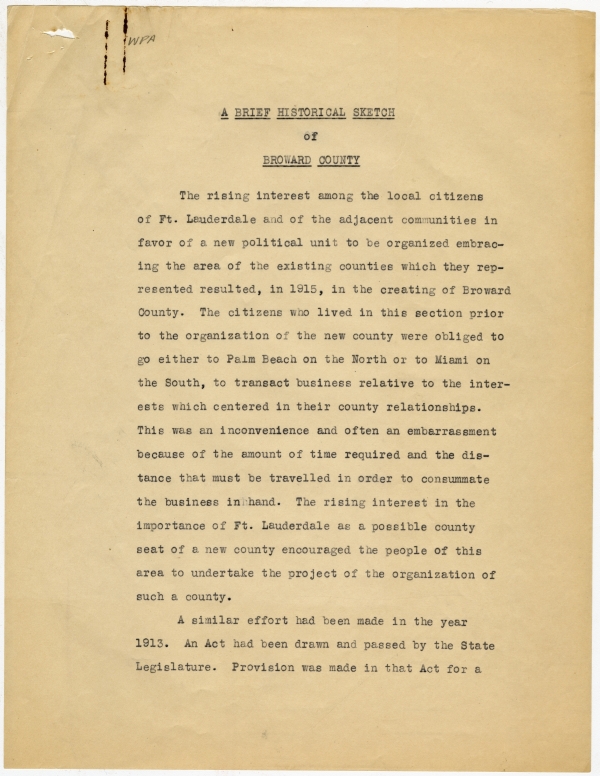


 Listen: The Folk Program
Listen: The Folk Program